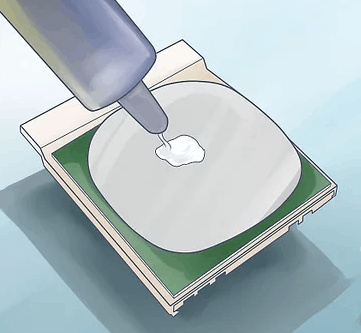The answers provided are good. But I have a couple issues with both of them.
First, it was not mentioned that you should thoroughly clean the old compound off. And, it's actually quite hard to get off unless you know the secret - Use electrical Contact Cleaner - it will dissolve the compound instantly and leave your surfaces clean and shiny. Use a q-tip or tissue. Alcohol does not work. You should NOT touch the surfaces with your fingers at all after cleaning them.
My recommended method of application (the one I have used probably hundreds of times now without issue) is to gently push the plunger of the Arctic Silver tube while you wipe the tip across the surface of the CPU. You want as thin of a layer as possible across the entire surface of the CPU while thoroughly covering all surface area.
The next trick to perfect the seat between the CPU and Heatsink is to install the heatsink. On Desktop computers you would clamp the heatsink down usually, but mobile computers and some desktops are screwed down. If it screws down, don't tighten the screws all the way. Then gently push down with pressure and gently twist (only slightly, a couple of degrees) back and forth on the heatsink. If using screws, finish tightening the heatsink screws down in a cross-diagonal pattern. Do not lift the heatsink back away from the CPU at any point after mating them together. This technique will squeeze the thermal compound down and make a perfect seal between the heatsink and the CPU.
If you doubt this, pull the heatsink back off. You'll see a perfect mate was made, as evidenced by the heatsink compound, between the CPU and heatsink. If you really pulled it off because you were curious, guess what, START OVER at step 1. :)

Very informative, but I'm still not clear on how I can be sure it will not spill out and short the pins. Do designers give installers a little margin for error (the height of the chip itself, perhaps?), or is this part of the gamble and if a little spews out while tightening the screws then the logic board is toasted? – Calaf – 2017-09-26T15:38:50.523
1There is not a gamble here. I said specifically, in bold, "You want as thin of a layer as possible..." The whole purpose of this stuff is to simply fill in the microscopic imperfections on the two surfaces. Also, this stuff doesn't "spill" out. It is thick and doesn't flow. Just use some common sense, less is more. – Appleoddity – 2017-09-26T18:18:27.490
Maybe it's easy after I've done it once or twice. One last clarification: I understand I shouldn't wiggle it, but should I at least feel some tack? Should I feel that the heatsink is sticking, in a very mild way, before knowing that it's a tight seal? – Calaf – 2017-09-26T18:59:05.317
Yes, with fresh compound it will feel a little sticky when you are wiggling. – Ben Franske – 2017-09-26T20:55:56.297